How the Colors of a Room Affect Moods
- Created: Friday, 16 February 2018 12:33
Why Room Color Matters
For reasons that aren’t fully understood, color affects the feeling of a space and the mood it creates. It can change how you feel when you’re in the room and even how you think and act. Research shows that color can affect you physically, including influencing your blood pressure, heart rate and breathing.
The right color choice can make a small room feel spacious or a large room cozier and more intimate. How room color affects mood can vary slightly from one person to the next, but general color families tend to have the same effect no matter who you are.
Since you don’t change your wall colors or furnishings very often, you want colors that make you feel good and support the type of activities that happen in each space. In the bedroom, you want colors that help you feel calm and relaxed so that you can sleep well. Ideal living room colors create a warm, inviting feeling. Keeping mood in mind when picking paint colors and other design elements in the room helps you set the desired atmosphere.
General Color Categories
Colors fall into three main categories: cool, warm and neutral. Being aware of these color groupings makes it easier to choose specific hues that achieve your goals for a space. You can narrow down the color families based on what you’re trying to do in the room. Keep these characteristics in mind:
- Cool colors: Purples, blues and greens with a bluish undertone fall into the cool color family. When you choose a cool color, you get a calming sensation, but the colors can also make the room feel cold. These colors often make rooms feel larger because they have a receding effect.
- Warm colors: Lying opposite the cool colors on the color wheel, warm colors include orange, red, yellow and yellow-green hues. Warm colors tend to make rooms seem smaller than cool colors do. In a large room, this can be positive, making the room feel cozy. If your room already feels small, warm colors can shrink it even more.
- Neutral colors: Neutral shades are the hues without color. Common neutral colors used in design include white, gray, beige and black. Many colors that fall under the neutral category have warm or cool undertones that can make them lean toward those qualities. White might have a warm yellow undertone or a cool blue undertone, for example.
Blue
Shades of blue fall into the cool color category. They have a calming and soothing impact on a space and can help you feel relaxed. This hue may lower your blood pressure, respiration and heart rate. Blue evokes a clean, fresh feeling, which is why it’s popular in bathrooms. It’s also associated with focus and productivity, so it works well in offices and similar spaces where you want to get work done.
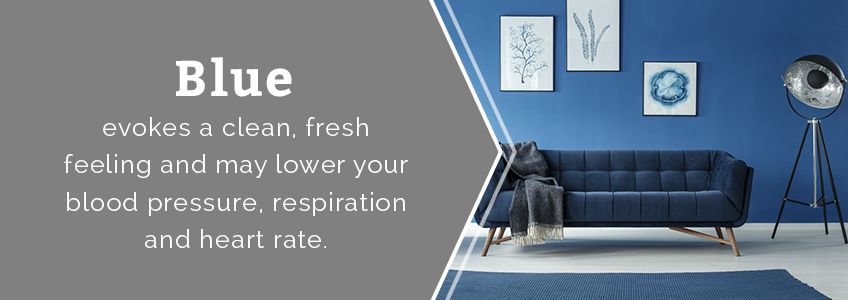
Some shades of blue come across as chilly on your wall, even if they look good on a small paint chip. That cool feeling can seem unwelcoming. Pastel blues, in particular, often give off an unapproachable, cold feeling. If you just can’t give up the idea of a chilly blue hue, reserve it for naturally light rooms to help warm up the space. You can also counterbalance the coolness by adding warm colors in the furnishings.
To avoid the chilly dilemma of painting a room blue, choose hues with warmer undertones. Some examples include periwinkle, cerulean and turquoise. Dark blues tend to create a sense of sadness, so it’s best to choose a softer shade as the main color in your room.
Use blue in rooms where you want a calm, meditative feeling like your bedroom and in places where you want to think clearly or focus, such as an office.
Green
Green is a versatile color that works almost anywhere. A mix of blue and yellow, this hue takes on the best qualities of both. You get a refreshing effect from the blue tones plus a cheerful punch from the yellow in the mix. Like blue, green creates a calming feeling in a room. It can help you relax and feel less stressed. Some people even think it prevents nightmares, which makes it an ideal choice for bedrooms.
Many people associate green with nature — particularly spring, when everything is fresh and new, which can inspire feelings of hope and anticipation while reducing anxiety. You can also change the feeling you get from green based on the specific hue you choose. Lime green has an energizing effect, for example. Deep greens like evergreen tone down a space. Earthy shades of green connect your space to nature.
Be careful not to go overboard with green. It can slow you down a little too much, causing a lethargic, lazy feeling or leading to moodiness and feelings of depression.
Yellow
Yellow adds a sunny, happy touch to your space. It tends to have an uplifting effect and may leave you feeling energized or spark your creativity. Research shows that yellow may help stimulate your memory and nervous system. It can also increase your blood pressure and pulse rate to some degree. Because it reflects light, yellow works well in small rooms or spaces without much natural light.
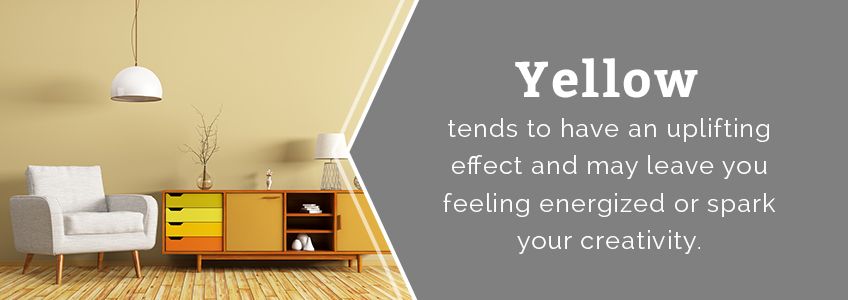
As happy as it is, yellow can have the opposite effect when used in large amounts. Some research shows that yellow in large quantities can cause anger or frustration. Even babies tend to cry more in overwhelmingly yellow rooms. Lots of bright yellow can also cause anxiety and fatigue. Soft, muted yellows tend to have a more positive effect than bright yellow hues. Muted hues promote a peaceful feeling, while buttery shades of yellow give your room cozy warmth.
Red
Red’s intensity gets your adrenaline pumping, raises your blood pressure and increases your respiration and heart rate, making it an energetic color with an exciting effect. That also means it may not be a good choice if you already have high blood pressure or hypertension. Red is considered a passionate color and sometimes creates a daring effect. It can encourage conversation, especially in shared spaces like living rooms. It’s said that red also increases the appetite and warms the body.
The shade of red you choose and the other colors in the room impact the overall atmosphere you create. If the red has an orange hue, it will be energizing. Red with purple undertones adds an intimate, quiet feeling. A hint of brown in the red shade creates a warm effect.
Purple
Purple spans from light lilac to deep eggplant. The effects of the color tend to vary depending on its depth. Light purple hues have a calming, restful feeling. Unlike blue, which has similar qualities, light purple doesn’t add the chilly effect to your room, so the space feels relaxing and inviting. Darker shades of purple add a dramatic touch with a rich, sophisticated look. Purple is often considered a spiritual color, and it’s also associated with royalty, luxury, power, ambition and mystery.
Orange
Energetic by nature, orange elevates your sense of enthusiasm and inspires you to move, which is why you often see it in gyms. Orange pulls in red’s excitement and balances it with the warmth and friendliness of yellow. You may find yourself feeling more creative when surrounded by orange. The color also creates a warm coziness that makes spaces feel inviting. Orange may help stimulate the appetite, which is great if you want to encourage eating but not so helpful if you’re trying to cut back on your portions.
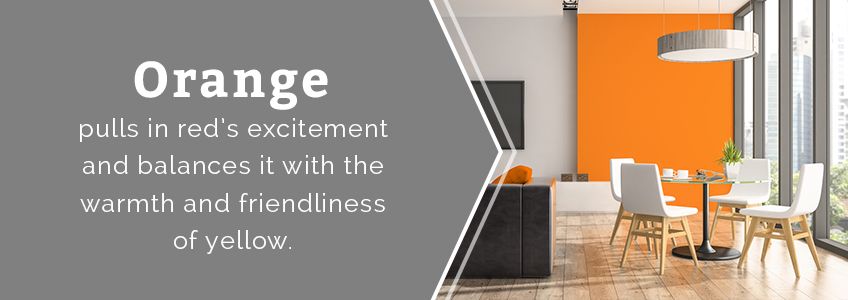
Not all orange hues are bright and bold. Work in warmer apricot or terra cotta for a relaxing feeling. Pairing these colors with brown or gray adds to their relaxing effect. Despite their bold appearance, deeper oranges tend to transform into cozy, warm hues at night, which is perfect for settling in after a long day.
Pink
Pink isn’t always the first choice for shared spaces, but it’s important to remember that bubblegum pink isn’t the only shade. This fun color evokes a lively, positive feeling in the space. It’s also known as a color with a soothing effect, but the result depends largely on the specific pink you choose. If you’re looking for soothing, go for blush or beige with pinkish tones. If you want to add energy with a glamorous, feminine edge, vivid pinks like fuchsia do the trick.
Black
While not a good idea as the main color for a room, black does have a grounding effect that can help in any room in small amounts. It can help tone down the rest of your colors and add depth to your design. Black gives the impression of authority, power and independence. Going overboard on black, however, can create feelings of depression or mood swings.
Color Recommendations by Room
As with all decorating, your choice in room color comes down to personal preference, but choosing colors best suited for the activity in a particular space can improve your satisfaction with the results. You may have a different desire for how a certain room makes you feel. For example, some people want calming, spa-like bathrooms while others want high-energy bathrooms to help them feel alert and awake in the morning.
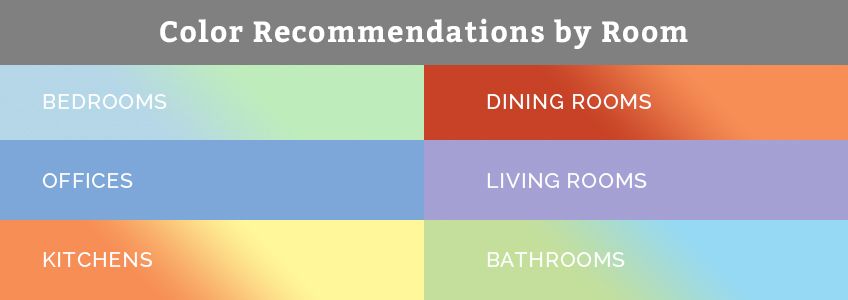
These recommendations by room can serve as a starting point for your decision:
- Bedrooms: Green or blue to create a tranquil, calming environment
- Offices: Blue to promote calm, focus and productivity
- Kitchens: Yellow for a bright, cheerful effect and to increase metabolism; orange for warmth
- Dining rooms: Red to spark your appetite; orange for warmth and to stimulate the appetite
- Living rooms: Lavender for a calming, relaxing effect
- Bathrooms: Light green or blue for a relaxing, spa-like feel; yellow for an awakening effect
Choosing the Right Color
Even with color psychology in mind, it can be challenging to select the right color for your décor. You might narrow down your bedroom options to green, but you still have hundreds of shades of green to consider. Keep these tips in mind for help choosing your room color:
- Don’t worry about trends: Decorating comes with lots of trends that change quickly. Instead of chasing the latest color that everyone is using, find something that appeals to you and that you can live with for at least a few years.
- Consider your personal reactions: While general colors tend to have the same effect on people, you may have a different reaction to certain colors. Maybe you aren't a fan of green, so it doesn't make you feel calm and relaxed. Choose colors that you like and that give you a positive feeling.
- Look at existing pieces: Unless you’re starting from scratch or completely renovating everything in your space, you likely already have design elements like furniture, carpet and textiles. Look to those pieces to find color inspiration. Your wall color and other new design elements need to work with those existing pieces to create a coordinated look. If you’re starting from scratch, choose a fabric or other design piece as a starting point.
- Test colors: You may like a color on a paint chip, but it doesn’t always look as appealing spread across your wall. Test out paint colors on a section of your wall before fully committing to the look. Check out the paint at different points in the day to see how it changes with lighting levels.
Tips for Incorporating Color
Since you don’t use just one color for an entire room, learning how to incorporate different hues and create appealing color combinations is an important part of decorating your space. To avoid a busy look, limit the number of colors you use in one space. A limit of three to four colors per room usually creates an interesting look without being overwhelming.
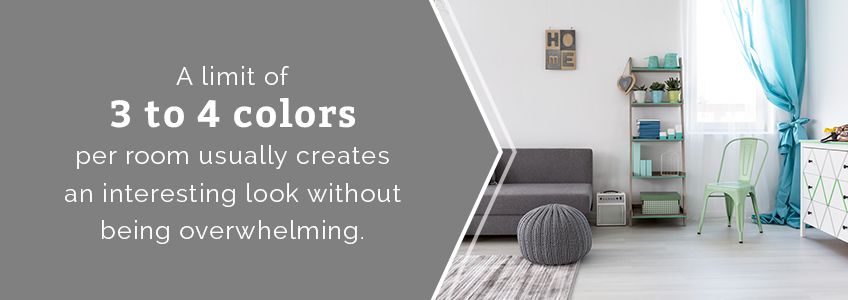
Choose your main room color carefully, especially if you’re considering something bold or bright. Even though the color may be known for its positive effects, too much of a good thing can take over the room or have the opposite effect. One way to avoid this issue is by choosing a neutral color for the walls or other large portions of the room with the brighter colors serving as accents. The general rule of thumb is the brighter or bolder the color, the less of it you need in your space to create the right look.
When choosing where to place bold, noticeable colors like orange or yellow, consider what you want people to notice. The eye naturally moves toward those bolder colors, so draw them to something you want to highlight like a unique architectural feature in the room or a favorite piece of artwork.
Incorporate both warm and cool colors into your room for balance. Having all cool colors can create a chilly look. When you bring in warmer accent pieces, you take the edge off that chilly impression.
Working with complementary colors — the hues that are opposite one another on the color wheel — can help create the look you want. Blue and orange are examples, as are red and green. Each pair of complementary colors includes one warm and one cool tone, and putting them together in your décor can make both colors appear more vivid than they would individually.
Add a Splash of Color to Your Home
Now that you know how colors affect your mood, you can control how each space makes you feel just by changing the hues in the room. Your paint selection isn’t the only way to add or balance out color in your, either. Choose neutral towels to tone down the colors, or add vividly colored towels to stir up certain emotions without repainting. Shop the Towel Super Center selection of towels to complement your current color palette and get the exact mood you want in your home right away.





